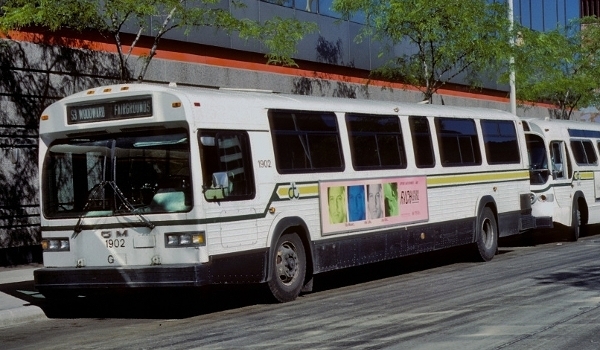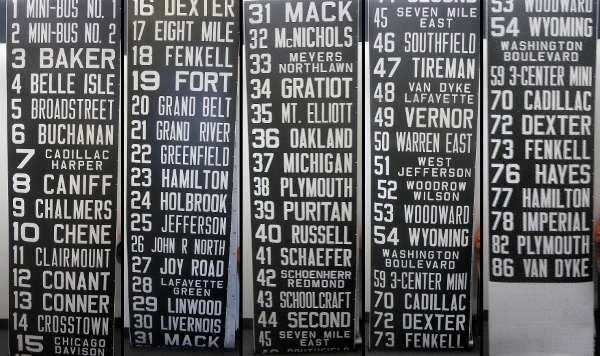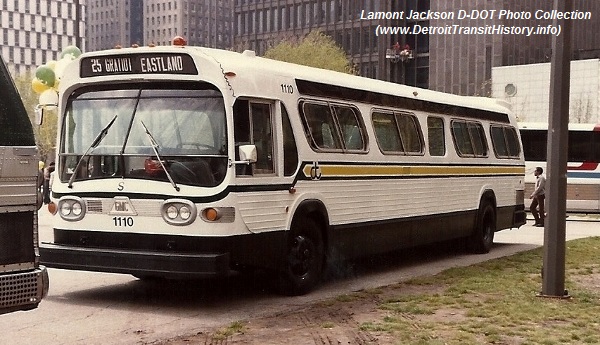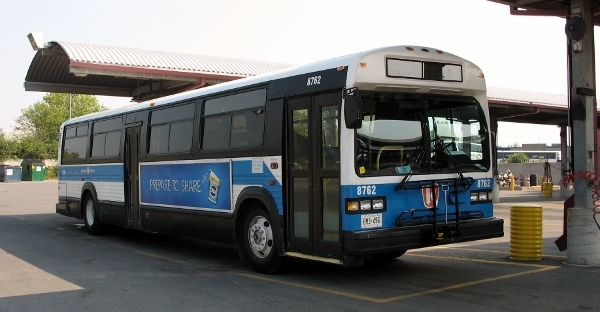| . |
| . |
| 1980-89 EQUIPMENT PHOTOS (Page 2) |
| FOR D-DOT 1980's MCI "CLASSIC" & NEOPLAN "ARTICS" (PAGE 3) CLICK "NEXT" (Below) |
© 2012 (PAGE LAST MODIFIED ON 11-14-12)
| . |
| . |
| Please click-on link to return to the "PHOTO GALLERY" Main Page. |
| . |
| In 1984, the Urban Mass Transportation Administration (UMTA) began diverting $53 million in federal funds already earmarked for southeastern Michigan transit projects (including the purchase of new buses) as part of a two-year ultimatum agreement with SEMTA to cover cost overruns on the Downtown People Mover—or forfeit completion of the project. Unfortunately, these sanctions (which also diverted $15 million in state aid) would have a major impact on the Detroit bus system, where 227 of its 725 coaches were more than 12 years old and eligible for retirement. The city now had to forgo an anticipated purchase of 67 new buses and a $3 million anti-theft fare box system. With no federal money expected for at least two years, the city now had to resort to only using city funds to make improvement to the DDOT bus fleet—primarily by overhauling ten year old coaches. In addition to rehabbing 89 coaches at a cost of $6.8 million in the spring of 1985, another 41 were rehabbed at $4.62 million later that fall. Meanwhile, despite this rehab campaign, severe coach shortages continued to plague the department. In April 1986, Mayor Coleman A. Young announced that the City of Detroit would spend $14.5 million in city general fund money to purchase 100 new buses and for other DDOT improvements. After having cited numerous mechanical issues with its newer 307-coach RTS fleet, DDOT would part ways with the GMC RTS and instead look elsewhere. |
D-DOT (Detroit Department Of Transportation)
| . |
| . |
| GMDD "CLASSIC" – MODEL TC40-102N |
| THE 1990's 1 2 3 |
| THE 2010's 1 2 |
| THE 2000's 1 2 |



| . |

| Dissatisfied with its problem-plagued RTS fleet and in desperate need of new buses, the Detroit Department of Transportation (DDOT) turned its back on the GMC built RTS coach and instead ordered 100 new "Classic" buses (#1900-1999) from GM of Canada during the early summer of 1986. At a cost of $12.7 million, this new DDOT fleet would be the first Detroit buses purchased solely with city funds since 1965. The "Classic" bus design (launched in 1983) was a continued version of the GM "New-Look" but featured a redesigned body style from the belt-line upward along with a new redesigned front end. In this Sept. 18, 1989 photo, DDOT coach #1975 can be seen parked at the Fairlane Mall Shopping Center while working the #22 Greenfield line. [Bernard Drouillard photo, courtesy of the James Husing Collection — see disclaimer below] |
| Between Aug–Sept 1986, the first 25 of these 49-passenger coaches (Model TC40-102N) were delivered to DDOT from the GMDD plant in Saint-Eustache (Montreal), Quebec. The first group (all non-wheelchair equipped) arrived out of numbering sequence; #1900-1910, #1934-1940, and #1968-1974. The "Classic" model features that most impressed DDOT officials included the increased visibility through the larger passenger windows and the wider front doors not offered on the New-Look design. In this June 5, 1991 photo, coach #1902 (one of the first 25 delivered) can be seen laying-over on Beaubien at E. Jefferson while working the #53 Woodward line. [Jim Beeler photo, courtesy of Melvin Bernero photobucket.com collection] |
| . |
| . |
| . |
| After the arrival of the GM of Canada built "Classics" in 1987, DDOT management decided to once again revise the paint scheme on its coach fleet. Black paint was now added to the entire lower skirt area–not just the bumpers, giving the coaches the same "black-bottom" look found on the #1900-series Classics. After the new DDOT Coach Rehabilitation Center opened at the Shoemaker Terminal in May of 1988, much of the rehabbing and repainting was done in house. |
| D-DOT FLEET UNDERGOES ANOTHER REVISED PAINT DESIGN |
| . |
| In 1977, GMC Truck & Coach in Pontiac, MI would discontinue production on its "New-Look" coach design, replacing it with a new redesigned transit coach—the RTS-II. Meanwhile, production of the "New-Look" would continue under GM of Canada's General Motors Diesel Division (GMDD), which did not offer the RTS. In May of 1983, GMDD would launch production on a slightly redesigned version of the "New-Look" it called the "Classic," and offered both designs between 1983–1986. Dissatisfied with the buses being manufactured in the U.S., many U.S. properties began placing orders with GMDD, including the Detroit bus system—DDOT. In 1985, GMDD announced that it was phasing-out production of the "New-Look" design in favor of the "Classic," and issued a call for transit operators interested in one final order of New-Looks. According to the book "GM New Look Bus" (by John H. McKane with Gerald L. Squire), the Detroit bus system (DDOT) was one of the operators initially interested in joining in on that final production order of New-Looks. However, after viewing and testing a Classic demonstrator, DDOT officials would decide instead to place an order for 100 of the GM of Canada (GMDD) "Classic" design coaches. The last New-Look order went to the Santa Monica Municipal Bus Lines, and was delivered in April 1986. |
| . |
| . |

| The #1900-series Classics were the last DDOT coaches to use Mylar roll-sign curtains to display their route and destination. The above images show an unrolled "Transign" street-side roller curtain from a DDOT #1900-series Classic coach. The roll-signs on the "Classics" were the only DDOT route signs to correctly display the adjusted route numbers used after the combined route #34 Michigan-Gratiot was once again split into two separate routes back on April 15, 1978. [Sign curtain photos courtesy of Nick Hauser via ex-DDOT coach sold to Kingston Transit] |
| The last of the #1900-series Classics were the 75 delivered between Nov. 1986 and April 1987, which completed the 100-coach order. Like the first group delivered, the last 75 were also not built in numerical order. However, twenty of these coaches (#1911, #1924-1932, #1960-1964, and #1995-1999) came equipped with mechanical wheel-chair lifts housed in the front-door, and only seated 47 passengers. In this photo, coach #1997—one of the last 75 delivered and also lift equipped—is seen parked at the Kern Block during a National Transportation Week display. [Lamont Jackson photo courtesy of the L. Jackson D-DOT photo collection] |
| The GMDD Classic fleet came equipped with a Detroit Diesel 6V-71N engine and an Allison V731 transmission. But to the disappointment of many, none of these city bought coaches came equipped with air-conditioning. However, two coaches (#1973 and 1974) came equipped with blue suburban-style passenger seats and were reserved for special Chartered Service operation. [Melvin Bernero photobucket.com collection, used by permission of Melvin Bernero] |

| After DDOT introduced its new redesigned "cross-over" paint scheme in 1989, the department would begin repainting its fleet with the new design. Although the majority of the #1900-series Classics would be repainted (like coach #1928 in photo), a few (such as #1948 - see next photo) would never be repainted. The last of the #1900-series Classics would be retired by 2002. [photo courtesy of the Michael Koprowicz Photo Collection] |
| . |
| . |

| After the Canadian government severely cut transit funding in 1995, many Canadian operators were forced to turn to refurbished second hand buses to maintain their fleets. The retirement of the DDOT #1900-series during the late-1990s resulted in many of these buses finding new homes in Canada. Although those in poor shape would be used for parts, a number of ex-DDOT Classics returned to service in a number of Ontario cities: including Guelph (6), Belleville (3), Cornwall (2), Sudbury (1), and Windsor (2). In this Oct. 2002 photo, ex-DDOT coaches #1949, 1948, 1990, and 1935 are pictured at Dupont Trolley of Quebec City, waiting to be refurbished. [Ex-DDOT Classic information and photo courtesy of Richard Oldfield] |
| LIFE AFTER D-DOT!! – DETROIT'S RETIRED #1900-SERIES "CLASSIC" FLEET |
| . |

| [Former DDOT coach #1947 became Transit Windsor coach #523] Two former DDOT Classic coaches would find a new home not too far from Detroit, right across the Detroit River in Windsor, Ontario, Canada. In January 2002, Transit Windsor acquired two retired DDOT coaches (#1933 and 1947) which were rebuilt as coaches #515 and 523. The two ex-DDOTs replaced two Windsor GMDD and MCI Classics (#515 & 523) that were removed from service due to accidents. Although coach #515 (ex-DDOT #1933) has since been retired, Transit Windsor coach #523 in photo (ex-DDOT #1947) is still listed as active as of 2012. [photo source: courtesy Canadian Public Transit Discussion Board – user "Girardin71"] |
| . |
| . |
| . |

| [Former DDOT coach #1960 (left) became Cornwall Transit coach #8761 (right)] The last of the former DDOT #1900-series Classics to find new homes in Ontario wound up in Cornwall, Ontario—Ontario's easternmost city, located just west of the Ontario/Quebec border. Two retired DDOT coaches, #1960 and 1953, were refurbished by Eastway Refurbishing of Burlington, Ontario and joined Cornwall Transit in the fall of 2003. DDOT coach #1960 (in left photo) would become Cornwall Transit coach #8761 (in right photo), while the former DDOT coach #1953 became Cornwall Transit #8762. Both were sold to Kingston Transit in 2005. [photos: Bernard Drouillard photo (l) – photo (r) and information courtesy of Richard Oldfield] |
| . |


| [Former DDOT coach #1956 became Belleville Transit coach #0254] Three of the former DDOT #1900-series Classics would find a new home in Belleville, Ontario, a small Canadian city about 120 miles east of Toronto. In 2002, retired DDOT coaches #1956, 1959, and 1944 were refurbished by Eastway Refurbishing of Burlington, Ontario and sold to Belleville Transit, becoming Belleville's #0254, 0255 and 0256 respectively. Although coach #0254 (ex-DDOT #1956) in this 2003 photo has since been retired, Belleville Transit coaches #0255 (ex-DDOT #1959) and #0256 (ex-DDOT #1944) are still listed as active as of 2012. [Ex-DDOT Classic information and photo courtesy of Richard Oldfield] |
| [Former DDOT coach #1942 became Clarington Transit coach #99] One of the former DDOT #1900-series Classics would find a new home in Clarington, Ontario, a city located along the eastern end of the Greater Toronto Area. Retired DDOT coach #1942 was refurbished by Dupont Trolley of Quebec City, becoming Clarington Transit coach #99. A roof-mounted Thermo King A/C unit was added as well as a Luminator Horizon LED sign. After Clarington Transit was merged into the regional Durham Region Transit in 2006, coach #99 was renumbered #8099. However, in 2008 the coach was sold to Transit Windsor and renumbered as coach #565. Transit Windsor #565 (ex-DDOT #1942) is still listed as active as of 2012. [Ex-DDOT Classic information and photo courtesy of Richard Oldfield] |
| . |

| Around 1988, DDOT would launch its new revised paint scheme. Although up to 150 coaches (including 12 of the #28-2900-series T8H-5307As–built in 1972) had been contracted out for major rebuilding, most of this new repainting was done at the new Rehab Center. In this photo, rehabbed coach #1110 is seen sporting its redesigned "black-bottom" paint scheme while parked at the Kern Block during a National Transportation Week display. Also note the former DSR replacement sign-curtain now being used in coach #1110 that displays route "#25 GRATIOT." [Lamont Jackson photo courtesy of the L. Jackson D-DOT photo collection] |

| The "black bottom" look was also added to the RTS fleet. In this April 1989 photo, coach #1502 can be seen sporting the new look while parked along-side the Shoemaker Terminal Office Bldg. [Melvin Bernero photobucket.com collection, used by permission of Melvin Bernero] |

| Coach #1827—one of the last fleet of GMC built DDOT RTSs purchased in 1980—is seen here parked at the Shoemaker Vehicle Maintenance Bldg. in October of 1988. The RTS repainting and rehabbing work was done only on the wheel-chair accessible RTS fleet. Most of the non-lift equipped RTSs purchased in 1978 (#1300-1369) would be retired beginning in 1990. [Melvin Bernero photobucket.com collection, used by permission of Melvin Bernero] |
| . |

| The original RTS fixed-window design allowed for very little outside fresh air into the interior of the coach. Because of these sealed passenger windows, outside ventilation was limited to a small driver's sliding cut-away window and two roof-mounted hatches. Unfortunately, this caused a problem when the coach's climate control system malfunctioned. As a result, GM designed a large vertical sliding sash window to allow fresh air into the coach. DDOT began installing these windows on their RTSs during the late-1980s. In this Oct 1988 photo, coach #1533 is parked on the Shoemaker Terminal property sporting its new paint job and sliding sash windows. [Melvin Bernero photobucket.com collection, used by permission of Melvin Bernero] |
| . |

| Rehabbed coach #1135— one of the #1000-1100-series New-Looks delivered in 1975— is seen here parked on the south-end of the Shoemaker Terminal property back in October of 1988, while sporting the new redesigned DDOT paint scheme. Both doors were painted all black on the repainted New-Looks. It was during the mid-1980s that DDOT began the short-lived practice of using the letter "C" "G" or "S" to identify which of the three terminals a coach was assigned. [Melvin Bernero photobucket.com collection, used by permission of Melvin Bernero] |
All Jim Husing Collection photos are posted with the permission of Mr. James Husing. Any distribution of photos for sale purposes is prohibited.
| . |

| [Former DDOT coach #1953 retired as Kingston Transit coach #8762] In 2005, Cornwall Transit sold its ex-DDOT coaches (#1960 and 1953) to Kingston—a small eastern Ontario city located on the north shore of Lake Ontario and the St Lawrence River. Both coaches would retain their Cornwall colors and fleet numbers; #8761 and 8762 (see photo) respectively. A Luminator Horizon LED sign had been added to both coaches when refurbished back in 2003. Both coaches were retired and scrapped by Kingston Transit around 2009. [photo and Kingston Transit information courtesy of Nick Hauser] |
SPECIAL ACKNOWLEDGMENTS:
A special Thank You! goes out to: Nick Hauser of Ottawa, Ontario, Canada, who contributed photos and information on ex-DDOT coach #1953 (Kingston
#8762) and photos of his DDOT roller-sign curtain obtained from former DDOT Classic coach (#1953 or 1960) eventually sold to Kingston Transit;
and to Richard Oldfield of Clarington/Oshawa DRT system for photos and information passed along (via the "DSR-2-DOT" Yahoo! discussion group) on the
history of former D-DOT GMDD Classics sold to various Ontario, Canada transit properties.
A special Thank You! goes out to: Nick Hauser of Ottawa, Ontario, Canada, who contributed photos and information on ex-DDOT coach #1953 (Kingston
#8762) and photos of his DDOT roller-sign curtain obtained from former DDOT Classic coach (#1953 or 1960) eventually sold to Kingston Transit;
and to Richard Oldfield of Clarington/Oshawa DRT system for photos and information passed along (via the "DSR-2-DOT" Yahoo! discussion group) on the
history of former D-DOT GMDD Classics sold to various Ontario, Canada transit properties.